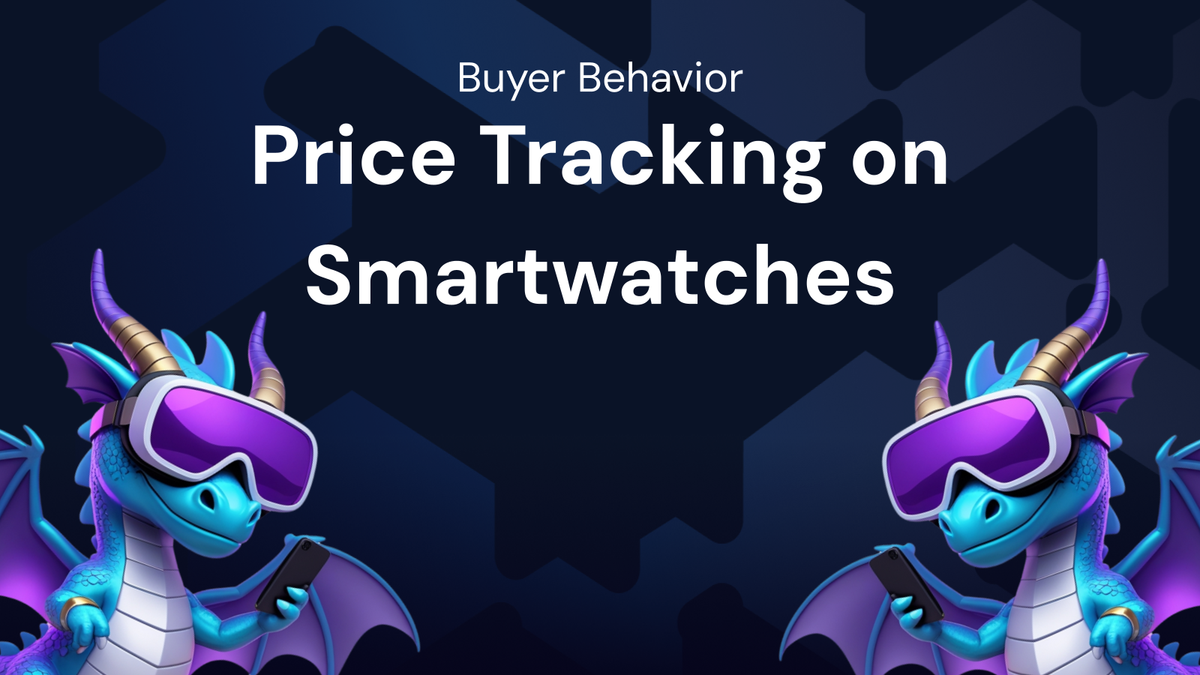How Price Tracking Influences Smartwatch Buyer Behavior

How Price Tracking Influences Smartwatch Buyer Behavior
The smartwatch market is booming. From fitness enthusiasts tracking their every step to tech-savvy individuals seeking seamless connectivity, smartwatches have rapidly evolved from niche gadgets to essential everyday companions. But with a plethora of models, features, and, most importantly, prices, entering the smartwatch market can feel overwhelming. This is where price tracking steps in, profoundly influencing buyer behavior and shaping the landscape of the smartwatch industry.
The Rise of the Smartwatch and the Importance of Price
Smartwatches offer a compelling blend of functionality, convenience, and style. They track activity levels, monitor heart rate, deliver notifications, allow for contactless payments, and even make phone calls. Leading brands like Apple, Samsung, Garmin, and Fitbit continuously push the boundaries of innovation, introducing new features and designs that cater to diverse user needs.
However, this innovation comes at a cost. Smartwatches range dramatically in price, from budget-friendly options under $100 to high-end models exceeding $1000. This price variation is influenced by factors such as:
- Brand Reputation: Established brands often command a premium due to their perceived quality, reliability, and brand loyalty.
- Features and Functionality: Advanced features like GPS, heart rate monitoring, blood oxygen saturation (SpO2) tracking, ECG capabilities, and cellular connectivity significantly impact the price.
- Materials and Design: Premium materials like titanium, sapphire glass, and intricate designs contribute to higher prices.
- Battery Life: Smartwatches with longer battery life are often priced higher due to more sophisticated battery technology.
- Software Ecosystem: Seamless integration with smartphone operating systems and access to a wide range of apps can justify a higher price point.
Given this complex pricing landscape, prospective buyers are increasingly turning to price tracking tools and strategies to make informed purchasing decisions. These tools empower consumers to monitor price fluctuations, identify deals, and ultimately secure the best possible value for their money.
Understanding Price Tracking and its Mechanisms
Price tracking, in its simplest form, is the process of monitoring the price of a specific product over time. This can be done manually by checking prices on various websites and retailers regularly, or, more commonly, by utilizing automated price tracking tools. These tools offer several advantages:
- Automated Monitoring: Eliminating the need for manual price checks, these tools continuously monitor prices across multiple online retailers.
- Price History Analysis: Providing a historical view of price fluctuations, allowing users to identify patterns and anticipate potential price drops.
- Price Drop Alerts: Notifying users when the price of a desired smartwatch falls below a specified threshold, ensuring they don't miss out on potential deals.
- Comparison Shopping: Displaying prices from various retailers side-by-side, facilitating quick and easy comparison.
- Coupon and Discount Integration: Automatically searching for and applying available coupons and discounts to maximize savings.
Several platforms and tools facilitate price tracking for smartwatches, including:
- Dedicated Price Tracking Websites/Apps: Websites like CamelCamelCamel (primarily for Amazon), PriceRunner, and ShopSavvy offer dedicated price tracking features with detailed price histories and alerts.
- Browser Extensions: Extensions like Honey and Rakuten (formerly Ebates) automatically search for coupons and cash-back offers while users browse online stores.
- Retailer-Specific Tools: Some retailers offer their own price tracking features or loyalty programs with price-matching guarantees.
- Google Shopping: Google Shopping allows users to track prices and receive notifications about price drops on products they're interested in.
By leveraging these tools, consumers gain a significant advantage in navigating the complex smartwatch market and making informed purchasing decisions.
How Price Tracking Influences Smartwatch Buyer Behavior
The availability and widespread adoption of price tracking tools have profoundly influenced smartwatch buyer behavior in several key ways:
- Increased Price Sensitivity: Price tracking empowers consumers to become more aware of price fluctuations and variations across different retailers. This heightened awareness makes them more price-sensitive, willing to postpone purchases until they identify a favorable deal. They are less likely to impulsively buy at the first available price, instead waiting for a price drop or a promotional offer.
- Strategic Timing of Purchases: Price tracking allows buyers to strategically time their purchases to coincide with periods of lower prices. They analyze price history data to identify patterns, such as seasonal sales events (e.g., Black Friday, Cyber Monday), manufacturer discounts, or clearance sales of older models. By waiting for these opportune moments, they can significantly reduce the cost of their desired smartwatch.
- Reduced Brand Loyalty: In a market saturated with competing smartwatch brands, price tracking can erode brand loyalty. Consumers who are primarily driven by price may be more willing to switch brands if they find a similar smartwatch with comparable features at a lower price point. The focus shifts from brand preference to value maximization.
- Informed Decision-Making: Price tracking is not just about finding the lowest price; it's also about gathering information and making informed decisions. By examining price history data, consumers can assess whether a current price is truly a good deal or simply a temporary promotion. They can also track the prices of different models and features to determine the best value for their needs and budget.
- Greater Transparency and Trust: Price tracking promotes greater transparency in the smartwatch market. By providing access to price history data and comparisons, these tools empower consumers to verify the legitimacy of promotions and discounts. This increased transparency fosters trust between consumers and retailers.
- Increased Negotiation Power: Armed with price tracking data, consumers can leverage this information to negotiate better deals with retailers. They can point out lower prices offered by competitors or request price matching to secure a more favorable price.
- Extended Research Phase: The availability of price tracking encourages consumers to engage in a more extended research phase before making a purchase. They are more likely to compare different models, read reviews, and analyze price trends before committing to a specific smartwatch. This extended research phase leads to more informed and ultimately more satisfying purchases.
- Increased Adoption of Refurbished or Used Options: Price tracking can also influence buyers to consider refurbished or used smartwatches as viable alternatives. By monitoring the prices of these options, consumers can identify significant savings compared to buying new. This trend contributes to a more sustainable consumer culture by extending the lifespan of electronic devices.
Impact on Retailers and Manufacturers
The widespread use of price tracking tools has also had a significant impact on retailers and manufacturers in the smartwatch industry.
- Increased Price Competition: Price tracking intensifies price competition among retailers. They are constantly monitoring each other's prices and adjusting their own accordingly to attract price-sensitive consumers. This can lead to a "race to the bottom," where profit margins are squeezed.
- Dynamic Pricing Strategies: Retailers are increasingly employing dynamic pricing strategies, where prices are adjusted in real-time based on factors such as demand, competitor pricing, and inventory levels. This allows them to optimize their pricing strategies and maximize profits in a highly competitive market.
- Importance of Value Proposition: In a price-sensitive market, retailers and manufacturers need to emphasize the value proposition of their products. They must clearly communicate the unique features, benefits, and quality of their smartwatches to justify their price points.
- Focus on Customer Loyalty: Retailers are investing more in customer loyalty programs and personalized offers to retain customers and prevent them from switching to competitors based solely on price.
- Transparency and Ethical Pricing: Retailers need to be transparent and ethical in their pricing practices. Deceptive pricing tactics, such as artificially inflated prices followed by fake discounts, can erode consumer trust and damage their reputation.
- Supply Chain Management: Efficient supply chain management is crucial for retailers to maintain competitive prices. By optimizing their supply chains, they can reduce costs and pass those savings on to consumers.
- Marketing and Promotion Strategies: Retailers need to develop effective marketing and promotion strategies to attract price-conscious consumers. This includes highlighting discounts, promotions, and value-added services.
The Future of Price Tracking in the Smartwatch Market
As the smartwatch market continues to evolve, price tracking is likely to become even more sophisticated and influential. We can expect to see:
- More Advanced Algorithms: Price tracking tools will leverage more advanced algorithms to predict price fluctuations and identify the best possible deals.
- AI-Powered Personalization: AI will be used to personalize price tracking based on individual user preferences, budget, and purchase history.
- Integration with Smart Home Devices: Price tracking could be integrated with smart home devices, such as smart speakers, allowing users to receive voice notifications about price drops.
- Augmented Reality (AR) Integration: AR could be used to overlay price information onto real-world products, allowing users to instantly compare prices while shopping in physical stores.
- Blockchain Technology: Blockchain technology could be used to ensure the accuracy and transparency of price data, preventing retailers from manipulating prices.
Conclusion
Price tracking has fundamentally altered the dynamics of the smartwatch market, empowering consumers with the information and tools they need to make informed purchasing decisions. By increasing price sensitivity, promoting strategic timing of purchases, reducing brand loyalty, and fostering greater transparency, price tracking has become an indispensable part of the smartwatch buying process.
For retailers and manufacturers, the rise of price tracking necessitates a greater focus on value proposition, customer loyalty, transparent pricing, and efficient supply chain management. As technology continues to advance, price tracking will only become more sophisticated and influential, further shaping the landscape of the smartwatch market and influencing buyer behavior. In this ever-evolving market, understanding the power of price tracking is crucial for both consumers and businesses alike.




